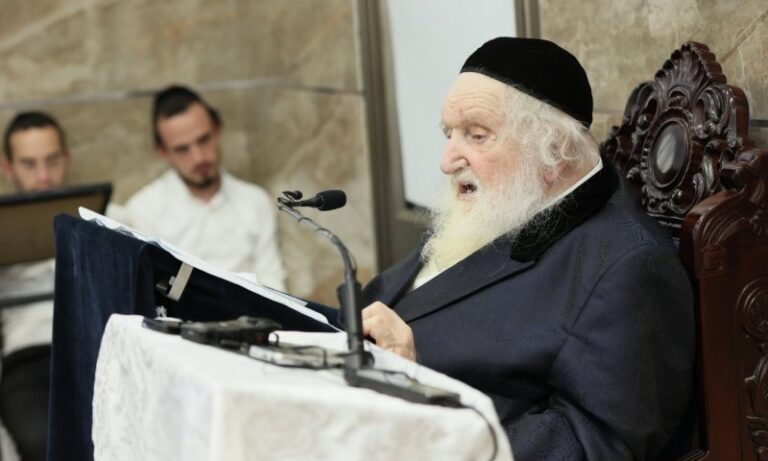(By Rabbi Yair Hoffman for the Five Towns Jewish Times)
When everything is said and done, what really matters is our relationship with Hashem. Which is why the new Shaarei Yechezkel Siddur, containing the mussar and Machshava of Rav Chatzkel Levenstein zatzal, is so worthwhile. This siddur can literally transform our davening, opening up new “gateways” in our Avodas Hashem.
A BEAUTIFUL THOUGHT
It is out of order, but here is a typical example: There is a beautiful thought (page 103) in, “Mechalkel chaim b’chessed.” The standard translation is that Hashem sustains life with chessed as an adverb. Rav Chatzkel explains that the word Chessed here is actually a noun. Therefore, how does Hashem sustain life? Not with bread – he sustains us with the concept of Chessed.”
RAV CHATZKEL
Rav Chatzkel zt”l was the mashgiach ruchani of the Mir Yeshiva, in Poland and in Shanghai during the war. Later he became the Mashgiach of the Ponovech Yeshiva. He had learned in Kelm and at Radin, thus being a Talmid of both Rav Simchah Zissel’s son and of the Chofetz Chaim. His son was Reb Nochum Velvel Ztz’l and his son in law wasReb Hirsh Broyde Ztz’l.
This Siddur, compiled by Rav Chatzkel’s grandson, Rabbi Yehudah Leib Ginzburg of Lakewood, contains remarkable nuggets culled from the vast Mussar oeuvre of this giant of Mussar thought. He took material from letters, seforim, lectures, pamphlets. It is clear that this grandson has a full mastery of his illustrious grandfather’s writings.
INTRODUCTORY THOUGHTS
As a general introduction, we are treated to thirteen insights from the Mashgiach about Tefilah – all of them serving to inspire us further.
• Tefilah is Rosh haMidos! What is Tefilah? It is self-effacement and unpretentiousness – the opposite of hubris – and this is everything!
• Let us not make our requests in Tefillah on account of our past actions. Rather, it should be requested as a matnas chinam – a free gift! This is what Tefillah is all about.
• Through tefillah, feelings of Emunah, hashgacha pratis and a closeness to Hashem are awakened. Through deep intensity of prayer one can achieve a tangible Emunah – which is the essence of it all
• The purpose of strengthening our Emunah in Tefillah is to disabue ourselves of the societal and natural tendency of thinking, “Kochi v’otzem yadi – my own initiative and efforts, the strength and power of my hand, has brought me all of this wealth..”
• Effort placed in Tefillah not only allows growth in one’s level of Tefilah – the person’s entire essence is transformed. He gains in all areas, kedusha, ahavah, yirah and dveikus.
• Tefillah is not just to get out of one’s personal vicissitudes – it is a means in and of itself. Indeed, tzaros are brought to us to allow us to soar in our Tefilos. If we only had this perspective at the outset we would not have tzaros.
• Tefillah educates us in the notion of Shivisi Hashem l’negdi samid and brings us to good midos and a firm realization of what our obligations in this world actually are.
• The only means to battle the yetzer harah is through Torah. But the means to achieve dveikus to Hashem – is only through Tefillah.
• Each Mitzvah has one particular limb that is integrally associated with it. For Tefillah – it is the heart.
• One who derelict in his Avodah of Tefillah is not even counted as a Maamin.
• Tefillah doesn’t change the ratzon Hashem; rather it makes the person worthy of receiving that change that he should have had in the first place.
There are two others in the introduction to the siddur as well – the reader should look at them himself (or herself).
The compiler of the siddur did a remarkable job, in that the notes and iyunim do not distract the person from what his or her central role should be – that of davening. It is often easy to get so caught up in the commentary that one loses focus. There is much skill in his ability to summarize and focus on the central point that will immediately enhance the Tefillah being analyzed. It is a remarkable achievement.
THE COMMENTARIES ON THE SIDDUR ITSELF
In the Siddur itself, we learn what the Modeh Ani recited each morning achieves. It is to entrench within us the thought that only Hashem grants us life – it is all from Him.
What’s the reason why we wait until all four Kadishes are recited before we remove our Tefillin? So that we not chas v’shalom show that it is perceived as a burden (page 5).
What’s the purpose of Elokai Neshama? Our realization that we are created beings helps distance us from narcissism and gaavah.
Why Psukei D’Zimrah? He cites a teaching from the Sabba of Kelm (page 47) that learning Mussar is a preparation for prayer. But all this only works when we come on time and recite Psukei D’Zimrah properly.
Why did Rabbi Shimon bar Yochai only stop for Krias Shmah and nothing else? Because one’s Torah must be from the perspective of Ol Malchus Shamayim (page 87) – otherwise the Torah is not Torah. [This gives us new perspective on some of the Torah coming out from the more dubious movements.]
We also learn that the Chofetz Chaim would describe how the desire we had for Torah in this world exists for us in the next world (page 86).
There is a special requirement to focus on the Ezras Avosainu – right before Shmoneh Esreh – because it declares the truth of His Malchus and his Hashgacha (page 95).
In Shmoneh Esreh his explanation of “Melech Ozer” (page 102) highlights the idea tat our obligation is to try and to prepare. Hashem will assist us and make up the rest.
In the Sefiras haOmer section, I was hoping to once again see Rav Chatzkel’s piece on how the 24,000 students of Rebbe Akiva had actually erroneously thought that giving Kavod to each other might actually be a stumbling block – and the lessons to be derived from that thought. However, the material the author included was very inspiring as well.
The Siddur too has useful Tefillos that are not found in other Siddurim: For example, there is a beautiful Yehi Ratzon to be recited on a parent’s Yahrtzeit that one’s learning should be l’ilui nishmasam.
The reviewer highly recommends this siddur. The author of the siidur can be reached at 732 966 7360.
The author can be reached at [email protected]











